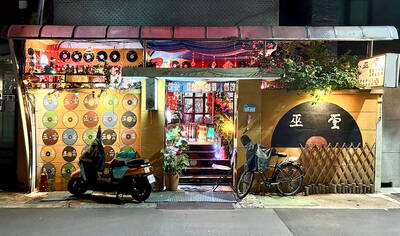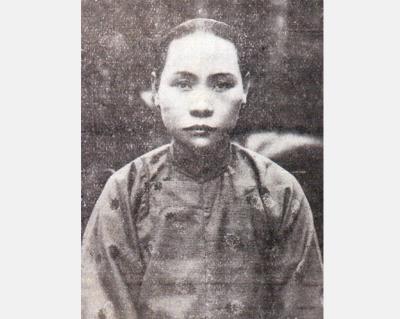Large portions at restaurants are often a cause for distress. Calories? Maybe. High cholesterol? Probably. Excessive fat? Definitely. When the waitress at Forkers’ spacious second location, which opened in May in an alley located less than five minutes by foot from the Zhongshan MRT Station (中山捷運站), brought the burger I ordered to my table, I began to wonder if North American-style excess had arrived in Taiwan. Breaking the old adage that we get what we pay for, the meal consisted of a humongous amount of delicious food: I didn’t eat for the rest of the day.
Forkers has earned a reputation for its creative play on the burger theme. With almost 50 varieties to choose from in four sections — “Forkers favorites,” “Western classics,” “Asian flavors,” and “the Forkers” (so-named because you need a knife and fork to eat them) — one could spend every day over the course of several weeks going through this part of the menu.
Some of the more eye-catching offerings include the eggs Benny burger (NT$290), the poutine burger (NT$250), artichoke gratin burger (NT$260) and a wasabi burger (NT$220).
Ordering is as simple as following the menu’s “five-step program.” After selecting a burger flavor, patrons choose from one of five patties: beef, chicken breast, fish, pork sausage or veggie. Step three, the “sides,” consists of choosing one of four types of fresh-cut fries (regular, Cajun, curry or garlic) and a salad (wild green, Dijon and dill potato, Hawaiian pasta or salad of the day). The process ends with ordering a (bottomless) drink and attempting to eat the mountainous meal.
The English burger (NT$230) that I ordered came open-faced and served on grain bread smeared with a moderate amount of garlic butter. Generously topped with sauteed onion and mushroom, the thick spice-infused beef patty underneath only became visible after using the serrated steak knife to cut it up. Each bite delivered a delicious medley of distinct flavors. The fries, hand cut from fresh potatoes, were crispy brown and lightly salted.
The salad of wild greens is no garden-variety iceberg lettuce afterthought. A variety of lettuce leaves were mixed together and artfully topped with cherry tomato, cucumber and baby corn. It came served with ranch dressing.
Forkers isn’t just about burgers. An extensive appetizer menu and large space make it ideal for a gathering with friends or office parties. Along with the usual offerings of nachos, tortilla wraps and chicken wings, it also has some harder-to-find fare such as pierogi rolls and warm artichoke and spinach dip.
Before heading to Forkers, I checked out several reviews of the original location on Chinese and English-language blogs. Two opinions stood out: the food was good but the service was mixed. I agree with the former, but found the service at the new location excellent — which is perhaps why the tip jar below the cash register was mostly full.
The original Forkers is at 8, Alley 10, Ln 223, Zhongxiao E Rd Sec 4, Taipei City (台北市忠孝東路四段223巷10弄8號).

The Lee (李) family migrated to Taiwan in trickles many decades ago. Born in Myanmar, they are ethnically Chinese and their first language is Yunnanese, from China’s Yunnan Province. Today, they run a cozy little restaurant in Taipei’s student stomping ground, near National Taiwan University (NTU), serving up a daily pre-selected menu that pays homage to their blended Yunnan-Burmese heritage, where lemongrass and curry leaves sit beside century egg and pickled woodear mushrooms. Wu Yun (巫雲) is more akin to a family home that has set up tables and chairs and welcomed strangers to cozy up and share a meal

Dec. 8 to Dec. 14 Chang-Lee Te-ho (張李德和) had her father’s words etched into stone as her personal motto: “Even as a woman, you should master at least one art.” She went on to excel in seven — classical poetry, lyrical poetry, calligraphy, painting, music, chess and embroidery — and was also a respected educator, charity organizer and provincial assemblywoman. Among her many monikers was “Poetry Mother” (詩媽). While her father Lee Chao-yuan’s (李昭元) phrasing reflected the social norms of the 1890s, it was relatively progressive for the time. He personally taught Chang-Lee the Chinese classics until she entered public

Last week writer Wei Lingling (魏玲靈) unloaded a remarkably conventional pro-China column in the Wall Street Journal (“From Bush’s Rebuke to Trump’s Whisper: Navigating a Geopolitical Flashpoint,” Dec 2, 2025). Wei alleged that in a phone call, US President Donald Trump advised Japanese Prime Minister Sanae Takaichi not to provoke the People’s Republic of China (PRC) over Taiwan. Wei’s claim was categorically denied by Japanese government sources. Trump’s call to Takaichi, Wei said, was just like the moment in 2003 when former US president George Bush stood next to former Chinese premier Wen Jia-bao (溫家寶) and criticized former president Chen

President William Lai (賴清德) has proposed a NT$1.25 trillion (US$40 billion) special eight-year budget that intends to bolster Taiwan’s national defense, with a “T-Dome” plan to create “an unassailable Taiwan, safeguarded by innovation and technology” as its centerpiece. This is an interesting test for the Chinese Nationalist Party (KMT), and how they handle it will likely provide some answers as to where the party currently stands. Naturally, the Lai administration and his Democratic Progressive Party (DPP) are for it, as are the Americans. The Chinese Communist Party (CCP) is not. The interests and agendas of those three are clear, but